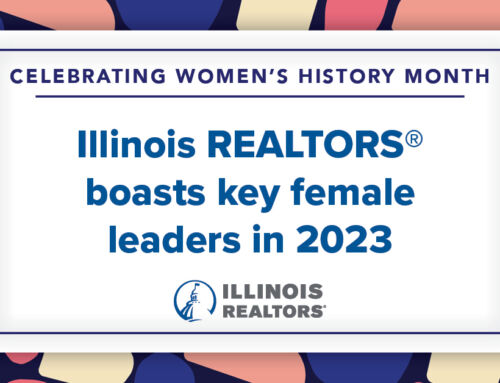Illinois State Comptroller Susana Mendoza and University of Minnesota law professor Myron Orfield may have spoken about different topics during the Illinois REALTORS® Public Policy Forum last week, but both made optimism an important part of their messages.
Both appeared virtually as part of the Illinois REALTORS® Online Fall Business Meetings. Mendoza assessed some of the economic issues in the state while it works through the COVID-19 pandemic and looks to the future. Orfield shared research data that showed how Chicago suburbs have become more diverse in the last 30 years and urged REALTORS® to use their influence to encourage equal treatment and opportunities for minorities in terms of mortgage credit and fair housing.
Mendoza and Orfield were two of many national and state experts who discussed key topics regarding the current and future state of the real estate industry.
Her ‘State of the State’ in the wake of COVID-19
Mendoza asked: “If Illinois was a piece of property and it was your job to sell it, what would you say about it?”
Illinois is similar to an older home that needs some updates but has sturdy bones, a fantastic location and a lot of charm, she said. Like REALTORS®, it is important for her to look for the positives or the more appealing aspects of her subject.
Her list of positives about Illinois include:
- a governor (J>B> Pritzker) who cares about the future of the state and its people,
- a Build Illinois program that will help rebuild infrastructure within the state,
- a renewed emphasis on investing in education.
 In the midst of the COVID-19 pandemic, she noted that the University of Illinois has developed a less invasive COVID-19 test that uses saliva instead of a nasal swab, and Southern Illinois University just received a grant to study the origins of COVID-19 and how it spreads.
In the midst of the COVID-19 pandemic, she noted that the University of Illinois has developed a less invasive COVID-19 test that uses saliva instead of a nasal swab, and Southern Illinois University just received a grant to study the origins of COVID-19 and how it spreads.
“This is amazing research happening right here in Illinois,” Mendoza said. “Our universities are hotbeds of creativity and innovation. And we need to celebrate and further invest in (them).”
In order for Illinois to recover from the pandemic, she urged REALTORS® to contact their Congressmen and Congresswomen and advocate for more federal assistance. “We’re not looking for a bailout,” she said. “We just asking for a lifeline from our federal partners. What the people of Illinois are going to need now, more than ever, when we emerge from this pandemic, is stability and predictability. Federal assistance will be a vital part of providing that.” Watch her full presentation.
His research and hopes for future of Illinois
It is in the economic best interests of REALTORS® to advocate for fair housing for all, according to Orfield, a former Minnesota legislator and a nationally recognized expert on the interplay of civil rights and regional development. Diverse communities tend to provide decent governmental services at affordable tax rates, experience better academic achievements from students and promote better racial understanding.
 The better the circumstances, the more successful the communities and the more vibrant the real estate market, said Orfield, who used research on the racial diversification of Chicago’s suburbs as the basis for his presentation. Unfortunately, discrimination continues to hinder African Americans and Latinos as they attempt to buy homes and live in certain communities. Access to information that would help them secure loans is one obstacle, and access to the same credit as their white neighbors is another, he said.
The better the circumstances, the more successful the communities and the more vibrant the real estate market, said Orfield, who used research on the racial diversification of Chicago’s suburbs as the basis for his presentation. Unfortunately, discrimination continues to hinder African Americans and Latinos as they attempt to buy homes and live in certain communities. Access to information that would help them secure loans is one obstacle, and access to the same credit as their white neighbors is another, he said.
For example, an African-American family that earns $167,000 in the United States is less likely to qualify for prime loan than a white family that earns $40,000, said Orfield, who was the architect of a series of important legislative changes in land use, fair housing, schools and local government aid programs.
Using color-coded maps of Chicago suburbs, Orfield showed how the racial demographics of 425 municipalities changed from 1990 to 2017. In 1990, 14 were predominantly non-white, 48 were diverse and 239 were mostly white. By 2017, 53 were predominantly non-white, 141 were diverse and 134 were predominately white.
“This is a huge change that happened in the last 30 years, very different than you would think about the suburbs in the 1970s when Martin Luther King Jr. was here, demonstrating for open housing on the south and west sides of Chicago,” he said.
However, despite the integration, some communities have not flourished, Orfield said. Some had very few of their own amenities, others lost their tax bases, and as the local governments struggled to provide services for residents, they stopped attracting a variety of newcomers. Some communities find themselves stuck in economic circumstances that are difficult to turn around.
But Orfield says if every community did its part to provide housing for residents of all economic levels, the resulting racial and cultural diversity would benefit everyone and prevent low-income housing from being concentrated in one place. He believes that the influence of REALTORS® could have a positive effect on legislation, policy and opinions people develop about their communities. Watch Orfield’s presentation.
























